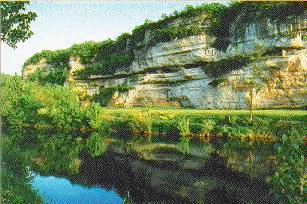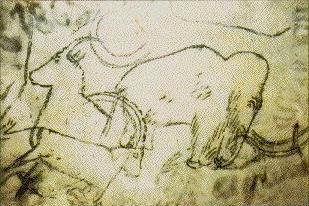My Summer Vacation
In July 1997 I vacationed in France, probably the country with the richest
record of prehistoric humanity in the world. The record is especially
rich in the Dordogne region of southwest France, and, within the Dordorgne,
around the village of Les Eyzies, the self-styled "World Capital of
Prehistory". I was lucky enough to be able to spend a few days there.
The first Cro-Magnon skeletons were discovered in 1868 under a rock
overhang at one end of town. A small plaque commemorates the discovery.
Nearby is the Abri Pataud archeological site. On the other end of town are
the Font de Gaume and Les Combarelles sites, both of which are open to the
public and contain cave paintings.
 Only a few kilometers out of town are the sites of La Madeleine (after
which the Magdalenian period is named), and Le Moustier (site of a famous
Neandertal skeleton discovered in 1908, and for which the Mousterian
toolkit used by Neandertals is named).
Only a few kilometers out of town are the sites of La Madeleine (after
which the Magdalenian period is named), and Le Moustier (site of a famous
Neandertal skeleton discovered in 1908, and for which the Mousterian
toolkit used by Neandertals is named).
The Musée National de Préhistoire is in the centre of the
village, perched underneath an overhanging cliff. There was a fascinating
temporary exhibition of pictures showing how Neandertals have been depicted
since their discovery. This museum is also one of the few places where you
can see a genuine hominid fossil: the partial skeleton of a
Neandertal infant from Roc de Marsal is exhibited to the public. Outside
the museum is the famous statue of a Neandertal done by Paul Darde in 1930.
 The cliff dwellings of Roque
St. Christophe have been inhabited almost continuously for over 50,000
years. There is a wonderful view out over the valley of the
Vézère River. The earliest inhabitants were Neandertals (a
diorama shows a Neandertal defending his family against a cave bear), but
during the middle ages a small fortified town of up to 1000 people lived on
the ledges and at the base of the cliff.
The cliff dwellings of Roque
St. Christophe have been inhabited almost continuously for over 50,000
years. There is a wonderful view out over the valley of the
Vézère River. The earliest inhabitants were Neandertals (a
diorama shows a Neandertal defending his family against a cave bear), but
during the middle ages a small fortified town of up to 1000 people lived on
the ledges and at the base of the cliff.
Very near Roque St. Christophe is the PréhistoParc
at Tursac. This
outdoor park has full-size dioramas of extinct animals, and of scenes from
Neandertal and Cro-Magnon life. The most elaborate scene is of a group of
Neandertals moving in to kill a mastodon which they have trapped in a pit
fall. This exhibit and a couple of others are enhanced by a soundtrack
which plays every 8 minutes and scares little kids very effectively.
 We weren't able to visit Lascaux or some of the other caves, since they are
heavily booked in advance. Fortunately, it was possible to visit the Grotte de
Rouffignac, about 20 km away, without any advance booking. Rouffignac
is especially famous for the large number of mammoths painted on its walls.
A small electric train takes visitors about a mile into the cave. The art
dates from about 13,000 years ago, and consists of monochrome line drawings
and carvings, not as spectacular as the more elaborate paintings at
Lascaux, but still very good. As well as the mammoths, there is an
especially good trio of woolly rhinoceroses. The Great Ceiling, deep
within the cave, contains a frieze of 66 animals done at a point where the
ceiling was originally only 2 or 3 feet high. The floor has been dug away
so that visitors are now able to walk into the chamber and look at the
whole ceiling.
We weren't able to visit Lascaux or some of the other caves, since they are
heavily booked in advance. Fortunately, it was possible to visit the Grotte de
Rouffignac, about 20 km away, without any advance booking. Rouffignac
is especially famous for the large number of mammoths painted on its walls.
A small electric train takes visitors about a mile into the cave. The art
dates from about 13,000 years ago, and consists of monochrome line drawings
and carvings, not as spectacular as the more elaborate paintings at
Lascaux, but still very good. As well as the mammoths, there is an
especially good trio of woolly rhinoceroses. The Great Ceiling, deep
within the cave, contains a frieze of 66 animals done at a point where the
ceiling was originally only 2 or 3 feet high. The floor has been dug away
so that visitors are now able to walk into the chamber and look at the
whole ceiling.
For anyone who is interested in prehistory, Les Eyzies is a destination
that should not be missed.
This page is part of the Fossil Hominids FAQ at the talk.origins Archive.
Home Page |
Species |
Fossils |
Creationism |
Reading |
References
Illustrations |
What's New |
Feedback |
Search |
Links |
Fiction
http://www.talkorigins.org/faqs/homs/eyzies.html, 11/11/97
Copyright © Jim Foley
|| Email me 
 Only a few kilometers out of town are the sites of La Madeleine (after
which the Magdalenian period is named), and Le Moustier (site of a famous
Neandertal skeleton discovered in 1908, and for which the Mousterian
toolkit used by Neandertals is named).
Only a few kilometers out of town are the sites of La Madeleine (after
which the Magdalenian period is named), and Le Moustier (site of a famous
Neandertal skeleton discovered in 1908, and for which the Mousterian
toolkit used by Neandertals is named).
 The cliff dwellings of
The cliff dwellings of  We weren't able to visit Lascaux or some of the other caves, since they are
heavily booked in advance. Fortunately, it was possible to visit the
We weren't able to visit Lascaux or some of the other caves, since they are
heavily booked in advance. Fortunately, it was possible to visit the 